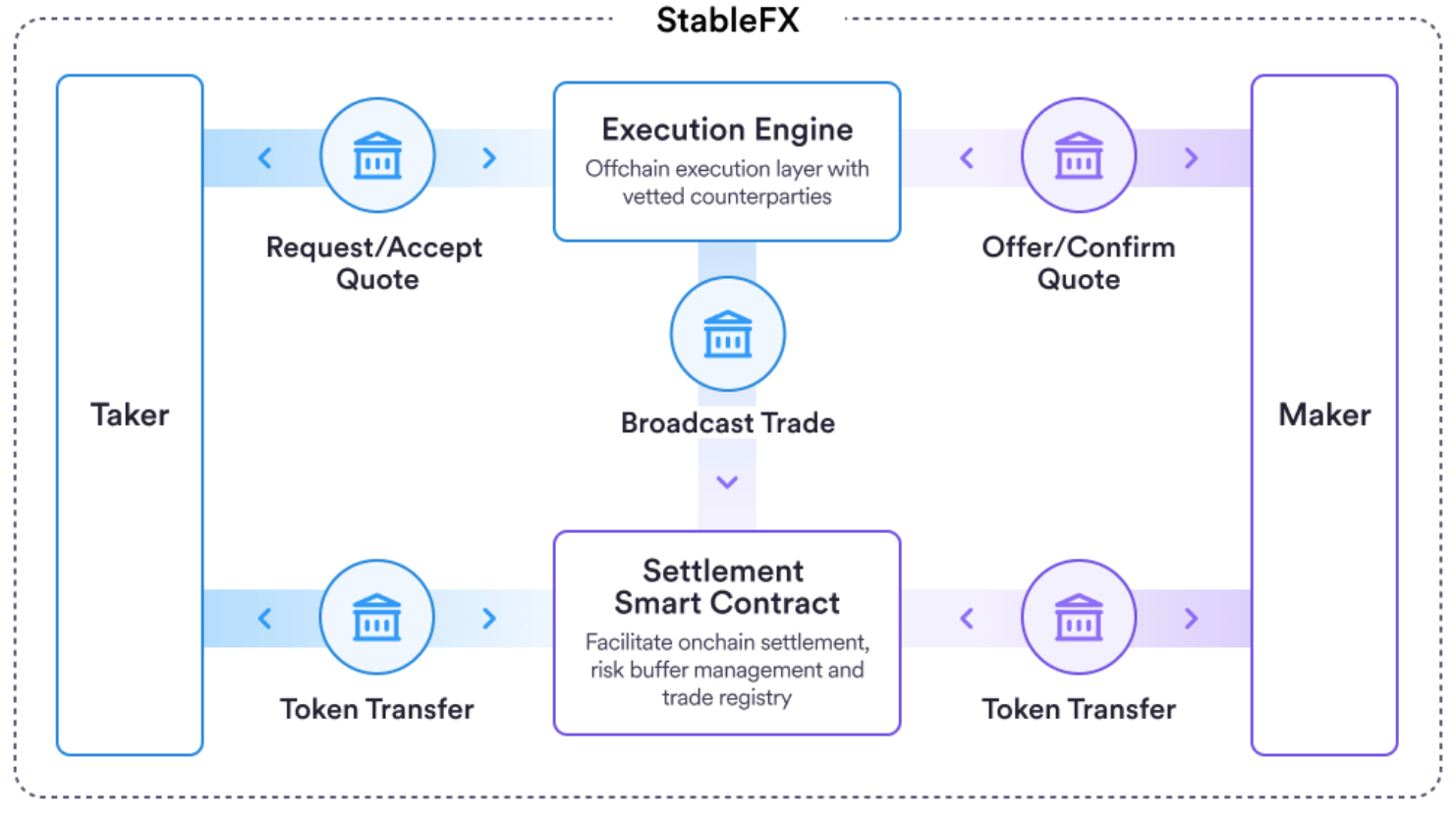Note: The StableFX execution engine provides offchain API methods for
performing the onchain settlements. It’s possible to integrate with StableFX
without broadcasting any onchain transactions.
Architecture
StableFX is composed of modular layers that form the FX infrastructure:
Execution engine
The execution engine is the offchain API that manages RFQ distribution, validation, and quote ranking between takers and makers. It provides an offchain API that can be used for price discovery, quote creation, and trade execution. The execution engine collects signatures and broadcasts them to the onchain contract for participants in StableFX.Settlement contract
The settlement contract is the smart contract on Arc that performs onchain escrow and delivery of both sides of a trade. Participants in StableFX can use the execution engine to submit their onchain transactions, or integrate with the smart contract directly, depending on their technical requirements.Quote request and trade execution
The following sections describe the quote request and trade execution process.Quote request
Takers use the StableFX API to request quotes. The taker can specify the amount of the sell currency or the buy currency in the quote request. The full quote request has the following properties:from.currency: The currency of the sell currencyfrom.amount: The amount of the sell currencyto.currency: The currency of the buy currencyto.amount: The amount of the buy currencytenor: The settlement schedule for the trade
tenor parameter specifies how long the trade should take to settle. The
available settlement schedules are instant, hourly, and daily.
instant: the settlement window is 30 minutes from trade creationhourly: the settlement window is 1 hour from trade creationdaily: the settlement window is 1 day from trade creation
- Invalid currency pair
- Amount less than the minimum trade amount (< 10 USDC)
Quote flow and fee calculation
The quote flow varies depending on what the taker specifies in their quote request. If the taker specifies an amount of the buy currency:- StableFX calculates the taker fee in the sell currency and adds the fee on top of the requested buy amount when requesting a quote from Talos
- Talos returns a quote for the combined amount
- StableFX returns to the taker the quoted combined amount and the fee in the buy currency; the taker understands that they receive the combined amount minus the fee
- StableFX sends the requested sell amount to Talos with no fee adjustment
- Talos returns a quote for the requested sell amount
- StableFX returns both the from and to amounts to the taker and separately adds the taker fee in the sell currency
Maker quote response
StableFX requests quotes from makers via the Talos platform. Makers choose the rate of exchange for their quote response. Circle has a subaccount in Talos for each settlement tenor. For makers, each subaccount is a unique customer, so through Talos they must support each of the settlement tenor customers.Quote acceptance
The taker accepts the quote by creating a trade through the execution engine. Creating the trade requires the quote ID and a randomly generated idempotency key. At this point, the quoted rate is locked in. This rate lock lasts until the trade expires, is settled, or is breached.Trade signature broadcasting
After the taker confirms the quote, the maker and taker submit their trade signatures to StableFX. StableFX verifies the signatures and broadcasts a contract function call to the smart contract. There is a 10 minute window for the maker and taker to submit signatures, or the trade will expire. The broadcast parameters include the maker and taker details including the trade consideration and signatures.Trade settlement
TheFxEscrow smart contract is used to settle the trade. This contract uses
the Permit2 contract to allow it to pull a specified amount of currency from
the maker and taker wallets to the contract.
Settlement model
StableFX implements a settlement model that is characterized by:- Explicit taker funding
- Maker-triggered settlement
- To the taker: the buy currency minus the taker fee
- To the maker: the sell currency minus the maker fee
- To the StableFX fee wallet: the StableFX taker fee in the buy currency and the StableFX maker fee in the sell currency
Wallets and funding
Makers and takers can use any Arc supported wallet to fund trades. Both makers and takers must use the same wallet throughout the course of a single trade. Wallets must be individually owned and not omnibus wallets. Wallets must support thePermit2 contract and be
capable of signing EIP-712 typed data without broadcasting the transaction.
Users must approve the Permit2 contract through the specific token contract
they’re using to fund trades.
Taker funding
To fund trades, the taker submits a signedPermit2 request to the FxEscrow
smart contract for trades with pending_settlement status using the contract
trade identifiers. This can be done with the StableFX API or by directly
transacting with the FxEscrow contract. The contract holds the taker funded
tokens until the trade is settled or breached.
Maker funding
The maker initiates a settlement transaction by funding trades that have been taker funded. When a maker identifies trades with statustaker_funded they can
submit a fund request to the FxEscrow smart contract. This can be done with the
StableFX API or by directly transacting with the FxEscrow contract.
Maker net funding
Makers can fund the net position of their accumulated trades with a given taker. This is done by calculating the net position and only submitting the funds required to cover the net position. For example, if a maker has an open trade with a taker where they are selling 100 USDC and buying 90 EURC, and another open trade with the same taker where they are selling 90 EURC and buying 100 USDC, their net position is 0. They would not need to submit any funds to theFxEscrow contract.